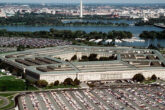December 02, 2016
Painting by Numbers: A History of the U.S. Military's Phasing Construct
Ask any budding student of security or member of the military where the focus of conflict is, and you’ll hear an emphatic “phase III operations.” The period in which decisive combat operations are undertaken is the meat and potatoes of America’s military. Glorified historical battles typically occurred in this phase, and most training and equipment is designed to operate in high-end conventional combat. Yet these high hopes have not proven decisive over the past 15 years. As Paul Scharre explored in the first two installments of this series, the phasing construct does not reflect reality. It was once valuable as a tool for force planning, but it has been applied too broadly and without sufficient utility.
Phasing’s Origins: The Unipolar Moment (1992-1993)
The origin of the phasing construct rests in the early post-Cold War era. Following decades of conflict against the Soviet Union and in the immediate aftermath of Operation Desert Storm, the U.S. Department of Defense went back to the drawing board to assess possible crises and evaluate force structure in light of the unipolar moment. The 1992 National Military Strategy contained many of the underlying concepts that later took form in the phasing construct, namely the idea of rapid decisive victory. The 1993 Bottom Up Review (BUR) matured this vision and presented the first iteration of the phasing construct for major regional conflicts that continues to inform operational planning today.
Read the full article at War on the Rocks.
More from CNAS
-
The Department of Defense’s Breakthrough Nuclear Moment Risks Slipping Away
Unless they act, the Department of Defense’s breakthrough nuclear moment may vanish before it really happens....
By Will Rogers
-
DEFAERO Strategy Series [Apr 09, 25] CNAS' Becca Wasser and Phil Sheers on Revitalizing the U.S. Defense Industrial Base
On this episode of the Defense & Aerospace Report Strategy Series, sponsored by General Atomics Aeronautical Systems, Becca Wasser and Phil Sheers of the Center for a New Amer...
By Becca Wasser & Philip Sheers
-
From Production Lines to Front Lines
Executive Summary The U.S. defense industrial base (DIB) is struggling to meet the demands of the current strategic environment—let alone prepare for a potential conflict agai...
By Becca Wasser & Philip Sheers
-
The Pentagon’s Endangered Brain Trust
In this environment, sound assessments of emerging threats and new ideas to counter them will be especially vital....
By Dr. Andrew Krepinevich, Jr.




